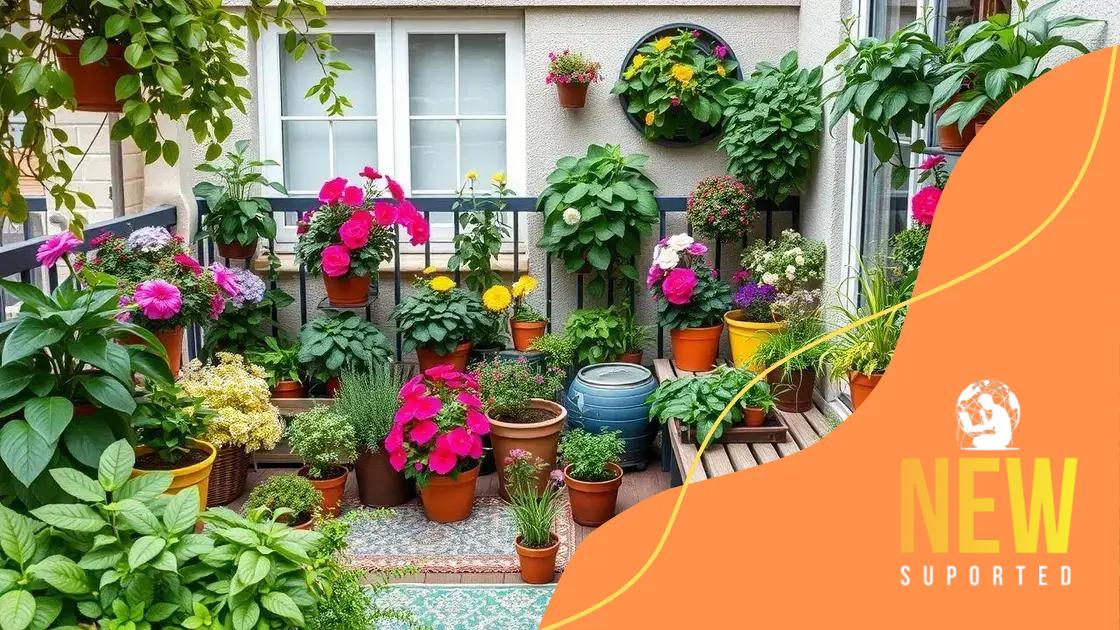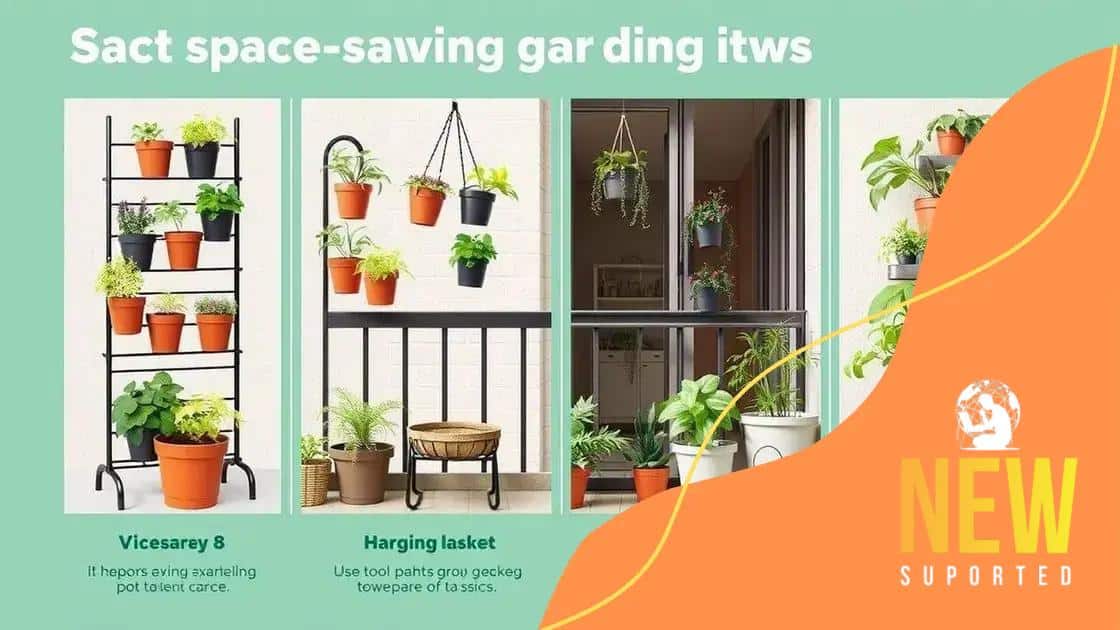Gardening tips for small apartment balconies

Creating a relaxing balcony oasis involves using comfortable seating, vibrant plants, ambient lighting, cozy textiles, and a water feature to transform your outdoor space into a tranquil retreat.
Are you curious about how to maximize your space? Gardening tips for small apartment balconies can transform your tiny outdoor area into a lush retreat. Let’s dive into practical ideas that can help you make the most of your balcony!
Choosing the right plants for small spaces
Choosing the right plants for small spaces can significantly enhance your balcony garden, providing color and life in limited areas. It’s essential to select plants that thrive in containers and can adapt to your environment. Here are some helpful tips to consider when making your selections.
Consider the Sunlight
Different plants have varying light requirements. Start by observing the amount of sunlight your balcony receives throughout the day. You may have areas that are sunny, shady, or a mix of both. Herbs, such as basil and parsley, thrive in full sun, while ferns and begonias prefer shadier spots.
Opt for Compact Varieties
Selecting compact plant varieties is a smart choice for small spaces. Many popular plants come in smaller versions that fit perfectly in containers. Consider:
- Dwarf tomatoes – perfect for balcony gardening.
- Miniature roses – they provide beauty without taking up much space.
- Child-sized fruit trees – like an apple tree bred specifically for containers.
- Succulents – they require minimal maintenance and add texture.
When choosing plants, it’s also wise to consider how they will grow together. Some plants can benefit from each other’s presence, a concept known as companion planting. For example, pairing basil with tomatoes can enhance the taste of both, while also repelling pests.
Choose the Right Containers
The right pot can help your plants thrive. Ensure that your containers provide adequate drainage and are sized appropriately for the plants you choose. Remember to select lightweight materials like plastic or resin if you need to move them around frequently.
In summary, taking the time to choose the right plants can make a world of difference in your small balcony garden. By considering sunlight, opting for compact varieties, and using the right containers, you can create a vibrant space that feels much larger than it is.
Essential tools for balcony gardening
Having the right tools can make a significant difference in your balcony gardening experience. With the right tools, you can efficiently manage your plants and ensure they thrive in their compact environment. Below are some essential tools that every balcony gardener should have.
1. Quality Containers
Investing in good quality containers is crucial for balcony gardening. Opt for pots with drainage holes to prevent waterlogging. You can find various sizes and materials like plastic, ceramic, or metal. Make sure the containers are lightweight if you need to move them.
2. Hand Tools
Hand tools are perfect for small spaces. A few essential tools include:
- Hand trowel – great for digging and planting.
- Pruning shears – essential for trimming and shaping plants.
- Weeder – helps remove unwanted plants efficiently.
- Garden gloves – protect your hands while you work.
These tools are often compact and easy to store, making them ideal for limited space.
3. Watering Equipment
Proper watering is vital for healthy plants. A small watering can or a spray bottle is often enough for container plants. Consider using a watering can with a long spout to help reach hanging plants. A drip irrigation system can also be beneficial if you want a hands-off approach.
Additionally, keep a moisture meter handy. This tool helps you know when your plants need watering, preventing over or under-watering.
4. Fertilizers
Using the right fertilizers can boost plant growth. Choose balanced, slow-release fertilizers that are suitable for container plants. Liquid fertilizers can also be beneficial, as they provide nutrients directly to the roots.
Finally, a gardening journal can be incredibly helpful to track your plants’ growth and the care they need. This way, you can document successes and learn from any challenges along the way. By gathering these essential tools, you’ll be prepared to create and maintain your beautiful balcony garden.
Space-saving gardening techniques

Space-saving gardening techniques are essential for making the most of your small balcony. With the right methods, you can maximize your growing area while still enjoying a beautiful garden. There are several effective strategies to help you grow plants in limited spaces.
Vertical Gardening
One of the most popular space-saving techniques is vertical gardening. This method allows you to grow plants upwards instead of outwards. You can use various structures like:
- Wall planters – attach them to your balcony walls for easy access.
- Vertical racks – these can hold multiple pots and allow for good airflow.
- Hanging baskets – place them from your balcony railing to add greens without taking up floor space.
Using vertical gardening not only saves space but also creates a stunning visual appeal.
Container Gardening
Container gardening is another effective technique. By choosing the right containers, you can grow a variety of plants in small areas. Use pots and containers that are:
- Stackable – these can be arranged in a way that utilizes vertical space.
- Self-watering – this reduces the frequency of watering and guarantees consistent moisture.
- Multi-compartment – they allow you to grow different plants in one container.
Container gardening makes it easier to manage your plants and can be tailored to fit any balcony size.
Companion Planting
Companion planting is a technique where you grow different plants together for mutual benefit. This can save space while enhancing plant health. For instance, planting basil close to tomatoes can improve both growth and flavor.
Additionally, you might want to consider using intercropping methods, where you plant quick-growing crops alongside slower ones to maximize productivity. This method helps you achieve a more diverse garden while using the same space efficiently.
Implementing these space-saving gardening techniques can transform your balcony into a lush retreat filled with vibrant plants, making the most of every square inch available.
Maintaining soil health in containers
Maintaining soil health in containers is crucial for thriving balcony gardens. Healthy soil ensures that your plants receive the necessary nutrients and water they need to grow strong. Here are some effective tips to help you keep your container soil in great condition.
1. Use High-Quality Potting Mix
Start with a high-quality potting mix designed for container gardening. Avoid using regular garden soil, as it may not have the proper drainage and aeration properties needed for potted plants. Look for mixes that contain components like peat moss, perlite, or compost.
2. Regularly Check Drainage
Drainage is vital for keeping soil healthy. Ensure that your containers have adequate drainage holes. If water collects at the bottom, it can lead to root rot. You can also place small stones at the bottom of your containers to improve drainage and airflow.
3. Fertilize Periodically
Container plants require regular nutrition because nutrients in potting mixes can deplete over time. Use a balanced, slow-release fertilizer to provide consistent nutrients. It’s also beneficial to add organic options like compost or worm castings to enrich the soil. Consider:
- Liquid fertilizers – they deliver immediate nutrients and can be used every few weeks.
- Granular fertilizers – these can be mixed into the soil at the start of the growing season for prolonged support.
- Organic options – like fish emulsion or seaweed extracts for natural growth.
Keep an eye on your plants; if they look weak or discolored, consider adjusting your fertilizing routine.
4. Monitor Watering Practices
Proper watering plays a crucial role in maintaining soil health. Container gardens can dry out quickly, but overwatering can be just as harmful. Check the soil moisture regularly by sticking your finger about an inch into the soil. Water only when the top layer feels dry.
In addition to proper watering, rotating your containers can also help maintain even moisture levels for all plants. This practice ensures that each plant receives adequate light and moisture, leading to healthier soil.
By following these simple tips, you can effectively maintain soil health in containers, ensuring that your balcony garden flourishes with vibrant plants that thrive in a healthy environment.
Creating a relaxing balcony oasis
Creating a relaxing balcony oasis is an ideal way to enhance your outdoor living space. With the right elements, you can transform your balcony into a peaceful retreat where you can unwind and enjoy nature. Here are some effective ideas to help you build your personal oasis.
1. Comfortable Seating
Investing in comfortable seating is crucial. Look for cozy chairs or a small sofa that suits your space. Adding cushions and throw pillows can make the seating even more inviting. Consider options that are weather-resistant to ensure durability.
2. Greenery and Plants
Incorporating lush greenery is essential in creating a calming atmosphere. Choose a variety of plants to add texture and color. Here are some great options:
- Ferns – perfect for shady areas.
- Flowering plants – like petunias or geraniums to brighten your space.
- Herbs – such as mint or rosemary that can also add fragrance.
Arrange your plants creatively in containers or vertical gardens to maximize space and enhance beauty.
3. Ambient Lighting
Lighting sets the mood, especially during the evening. Consider using:
- String lights – these add a magical touch and can be draped around railings.
- Candles – they provide soft, warm light and create a relaxing ambiance.
- Lanterns – for a charming aesthetic that can be placed on tables or hung up.
These lighting options will help you enjoy your balcony even after sunset.
4. Cozy Textiles
Adding textiles can enhance comfort and warmth. Use outdoor rugs to define the space and add visual interest. Soft blankets can keep you warm on cooler evenings, making the balcony a year-round retreat. Choose colors and patterns that reflect your personal style.
5. A Water Feature
Incorporating a small water feature can bring a soothing element to your oasis. Consider a tabletop fountain or a small birdbath. The sound of trickling water can create a peaceful atmosphere and attract wildlife, adding to the natural feel of your space.
By combining these elements, you can successfully create a relaxing balcony oasis that serves as your personal sanctuary in the heart of the city.
FAQ – Frequently Asked Questions about Creating a Relaxing Balcony Oasis
What are some essential elements for a relaxing balcony oasis?
Essential elements include comfortable seating, vibrant plants, ambient lighting, cozy textiles, and optionally a water feature.
How can I choose the right plants for my balcony?
Select plants that thrive in containers and suit your climate; consider using herbs, flowering plants, and greenery for visual appeal.
What type of seating is best for a small balcony?
Opt for lightweight, weather-resistant furniture such as foldable chairs or a compact sofa that can accommodate your space.
How do I create a calming atmosphere on my balcony?
Use soft lighting, add comfortable cushions, incorporate natural elements like plants, and consider soothing colors in your decor.






